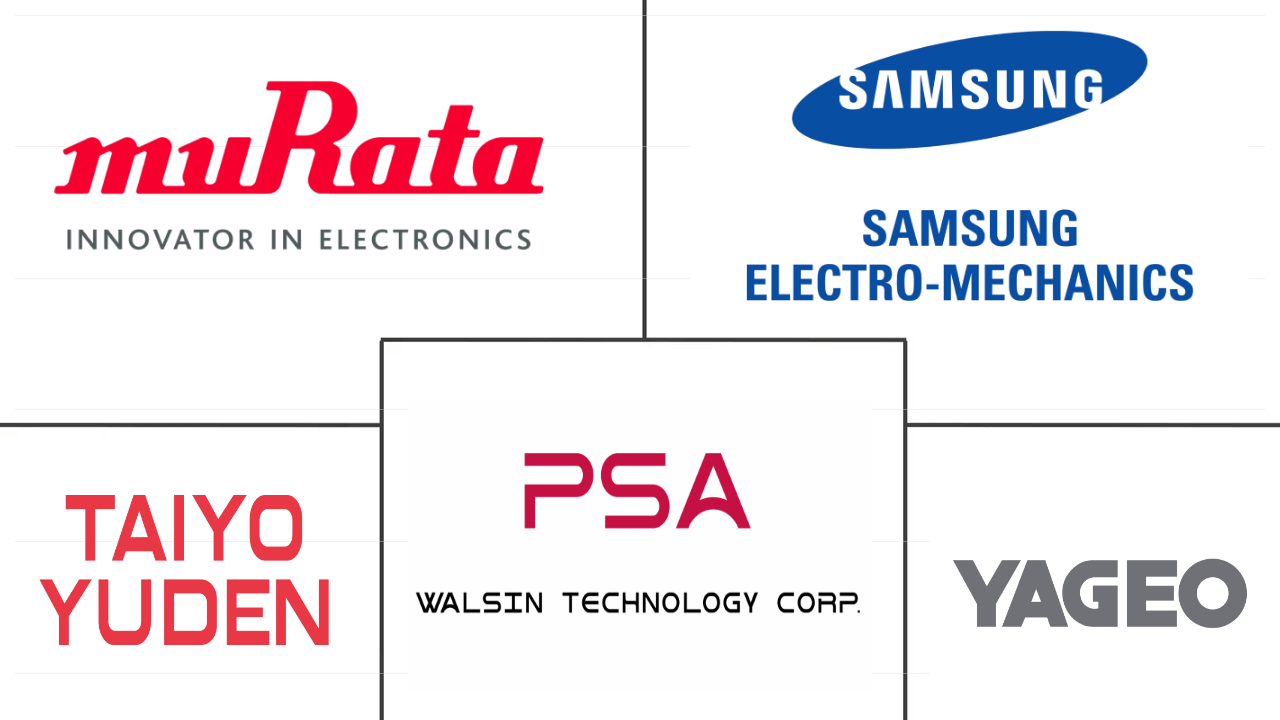Market Size of telecommunication mlcc Industry
| Icons | Lable | Value |
|---|---|---|
|
|
Study Period | 2017 - 2029 |
|
|
Market Size (2024) | USD 1.35 Billion |
|
|
Market Size (2029) | USD 3.61 Billion |
|
|
Largest Share by Case Size | 0 402 |
|
|
CAGR (2024 - 2029) | 21.70 % |
|
|
Largest Share by Region | Asia-Pacific |
|
|
Market Concentration | Medium |
Major Players |
||

|
||
|
*Disclaimer: Major Players sorted in no particular order |
Telecommunication MLCC Market Analysis
The Telecommunication MLCC Market size is estimated at 1.35 billion USD in 2024, and is expected to reach 3.61 billion USD by 2029, growing at a CAGR of 21.70% during the forecast period (2024-2029).
1.35 Billion
Market Size in 2024 (USD)
3.61 Billion
Market Size in 2029 (USD)
17.25 %
CAGR (2017-2023)
21.70 %
CAGR (2024-2029)
Largest Segment by DeviceType
35.31 %
value share, Set Top Boxes, 2023

The surging adoption of artificial intelligence (AI) in set-top boxes, the rising internet penetration and broadband adoption in emerging economies, and the continuous deployment of OS-based devices are driving the demand for set-top boxes.
Fastest Segment by Case Size
19.27 %
Projected CAGR, 0 201, 2024-2029
The ongoing trend of miniaturization of these MLCCs, along with the requirement for increased component density, is driving the demand for components that can be used in the telecom sector.
Fastest Segment by Capacitance
21.77 %
Projected CAGR, More than 100 μF, 2024-2029

5G communication technology has boosted the demand for base station equipment, thus, in turn, fueling the demand for high-performance and high-reliability MLCCs.
Largest Segment by Dielectric Type
60.24 %
value share, Class 2, 2023

The demand for Class 2 dielectric-type MLCCs like X7R is on the rise due to their resistance to high temperatures (125°C or higher) and reliability in demanding base station environments.
Fastest Segment by Region
24.19 %
Projected CAGR, Europe, 2024-2029

5G base station deployments are increasing with the 5G rollout in the region, which may lead to an increase in the demand for MLCCs in base stations.
Different case sizes are fueling the evolution of telecommunication MLCCs
- The telecommunication MLCC market is undergoing a profound transformation, driven by technological advancements and the demand for compact yet high-performance electronic components. Within the "by case size" segment, five key categories stand out: 0 201, 0 402, 0 603, 1 005, and 1 210. Each case size plays a pivotal role in shaping the industry's evolution.
- The 0 201 case size is central to meeting evolving industry demands. Demonstrating strong growth, this segment generated USD 145.29 million in revenue in 2022. Its compact form factor aligns with the need for space optimization in devices like set-top boxes (STBs), which is crucial for enabling advanced features such as 4K HDR and Dolby Atmos support.
- The 0 603 case size represents collaborative progress and technological innovation. Its compact form factor complements strategic collaborations, exemplified by China Telecom and China Unicom's 5G network sharing initiative. Case Size 1 005 accommodates these innovations, allowing personalized services and efficient bandwidth utilization. Partnerships like ADB and KAONMEDIA leverage this case size to introduce cutting-edge technologies, enhancing device performance.
- The 1 210 case size plays a significant role in telecom infrastructure. It enables efficient signal processing, power conversion, and RF circuitry within base stations. Innovations like Ubiik's freeRANTM and Qualcomm's Compact Macro 5G RAN Platform exemplify the demand for high-performance components.
- Case sizes of all types in the telecommunication market with compact yet powerful components for advanced STBs to efficiently signal processing in base stations contribute to the industry's progress, offering a balance between size constraints and technological capabilities.
The demand for MLCCs is growing in the global telecommunication infrastructure
- The global telecommunication sector is experiencing dynamic growth, driven by the rapid deployment of 5G networks and the increasing demand for high-speed connectivity and advanced communication services.
- Asia-Pacific is at the forefront of the telecommunications industry's surge, marked by the widespread adoption of smartphones, data services, and digital content. Countries such as China are pioneering the deployment of 5G technology, with millions of operational 5G base stations. The demand for MLCCs in the region is substantial, driven by the need for efficient communication base stations that can withstand high temperatures and maintain signal integrity. As the region continues to innovate and lead in telecommunications, the demand for MLCCs remains strong.
- The United States is a key player in the global telecommunication sector, making significant strides in establishing the national 5G network. With tech giants like AT&T, Verizon, and T-Mobile investing heavily in 5G technology, the demand for MLCCs in communication base stations is on the rise.
- Europe has witnessed a surge in mobile applications and services, driving the need for enhanced telecommunications infrastructure. The deployment of 5G networks across countries like the United Kingdom, Germany, France, and Spain has led to an increased demand for base stations. MLCCs are playing a critical role in enabling the advanced functionalities of 5G, such as higher data rates and reduced latency.
- Middle East & Africa is undergoing a significant transformation with the rapid deployment of 5G networks. As commercial 5G services are introduced across the region, the demand for MLCCs in the Rest of the World has surged.
Telecommunication MLCC Industry Segmentation
Base Stations, Set Top Boxes, Others are covered as segments by Device Type. 0 201, 0 402, 0 603, 1 005, 1 210, Others are covered as segments by Case Size. 50V to 200V, Less than 50V, More than 200V are covered as segments by Voltage. 10 μF to 100 μF, Less than 10 μF, More than 100 μF are covered as segments by Capacitance. Class 1, Class 2 are covered as segments by Dielectric Type. Asia-Pacific, Europe, North America are covered as segments by Region.
- The telecommunication MLCC market is undergoing a profound transformation, driven by technological advancements and the demand for compact yet high-performance electronic components. Within the "by case size" segment, five key categories stand out: 0 201, 0 402, 0 603, 1 005, and 1 210. Each case size plays a pivotal role in shaping the industry's evolution.
- The 0 201 case size is central to meeting evolving industry demands. Demonstrating strong growth, this segment generated USD 145.29 million in revenue in 2022. Its compact form factor aligns with the need for space optimization in devices like set-top boxes (STBs), which is crucial for enabling advanced features such as 4K HDR and Dolby Atmos support.
- The 0 603 case size represents collaborative progress and technological innovation. Its compact form factor complements strategic collaborations, exemplified by China Telecom and China Unicom's 5G network sharing initiative. Case Size 1 005 accommodates these innovations, allowing personalized services and efficient bandwidth utilization. Partnerships like ADB and KAONMEDIA leverage this case size to introduce cutting-edge technologies, enhancing device performance.
- The 1 210 case size plays a significant role in telecom infrastructure. It enables efficient signal processing, power conversion, and RF circuitry within base stations. Innovations like Ubiik's freeRANTM and Qualcomm's Compact Macro 5G RAN Platform exemplify the demand for high-performance components.
- Case sizes of all types in the telecommunication market with compact yet powerful components for advanced STBs to efficiently signal processing in base stations contribute to the industry's progress, offering a balance between size constraints and technological capabilities.
| Device Type | |
| Base Stations | |
| Set Top Boxes | |
| Others |
| Case Size | |
| 0 201 | |
| 0 402 | |
| 0 603 | |
| 1 005 | |
| 1 210 | |
| Others |
| Voltage | |
| 50V to 200V | |
| Less than 50V | |
| More than 200V |
| Capacitance | |
| 10 μF to 100 μF | |
| Less than 10 μF | |
| More than 100 μF |
| Dielectric Type | |
| Class 1 | |
| Class 2 |
| Region | |
| Asia-Pacific | |
| Europe | |
| North America | |
| Rest of the World |
Telecommunication MLCC Market Size Summary
The telecommunication MLCC market is experiencing significant growth, driven by the rapid advancement of technology and the increasing demand for compact, high-performance electronic components. This market is characterized by various case sizes, each contributing to the industry's evolution. The 0 201 case size is particularly important for devices like set-top boxes, while the 0 603 case size supports strategic collaborations in 5G network sharing. The 1 005 case size facilitates personalized services and efficient bandwidth utilization, and the 1 210 case size is crucial for telecom infrastructure, enabling efficient signal processing and power conversion. The global telecommunication sector is expanding rapidly, with Asia-Pacific leading the charge due to widespread 5G adoption. The United States and Europe are also key players, investing heavily in 5G technology and infrastructure. The Middle East and Africa are witnessing a transformation with the deployment of 5G networks, further driving the demand for MLCCs.
The market is moderately consolidated, with major players like Murata Manufacturing, Samsung Electro-Mechanics, Taiyo Yuden, Walsin Technology Corporation, and Yageo Corporation holding significant shares. These companies are innovating to meet the growing demand for MLCCs in various applications, including 5G fixed wireless access devices, which are expected to see exponential growth. While the focus is on 5G technology, the continued significance of 4G and other technologies remains, as MLCCs are essential for power management and signal filtering in devices like smartphones and IoT devices. The market's growth presents substantial opportunities for MLCC manufacturers, who must align production and supply capabilities to meet the specific requirements of emerging technologies.
Telecommunication MLCC Market Size - Table of Contents
-
1. MARKET SEGMENTATION (includes market size in Value in USD and Volume, Forecasts up to 2029 and analysis of growth prospects)
-
1.1 Device Type
-
1.1.1 Base Stations
-
1.1.2 Set Top Boxes
-
1.1.3 Others
-
-
1.2 Case Size
-
1.2.1 0 201
-
1.2.2 0 402
-
1.2.3 0 603
-
1.2.4 1 005
-
1.2.5 1 210
-
1.2.6 Others
-
-
1.3 Voltage
-
1.3.1 50V to 200V
-
1.3.2 Less than 50V
-
1.3.3 More than 200V
-
-
1.4 Capacitance
-
1.4.1 10 μF to 100 μF
-
1.4.2 Less than 10 μF
-
1.4.3 More than 100 μF
-
-
1.5 Dielectric Type
-
1.5.1 Class 1
-
1.5.2 Class 2
-
-
1.6 Region
-
1.6.1 Asia-Pacific
-
1.6.2 Europe
-
1.6.3 North America
-
1.6.4 Rest of the World
-
-
Telecommunication MLCC Market Size FAQs
How big is the Global Telecommunication MLCC Market?
The Global Telecommunication MLCC Market size is expected to reach USD 1.35 billion in 2024 and grow at a CAGR of 21.70% to reach USD 3.61 billion by 2029.
What is the current Global Telecommunication MLCC Market size?
In 2024, the Global Telecommunication MLCC Market size is expected to reach USD 1.35 billion.

